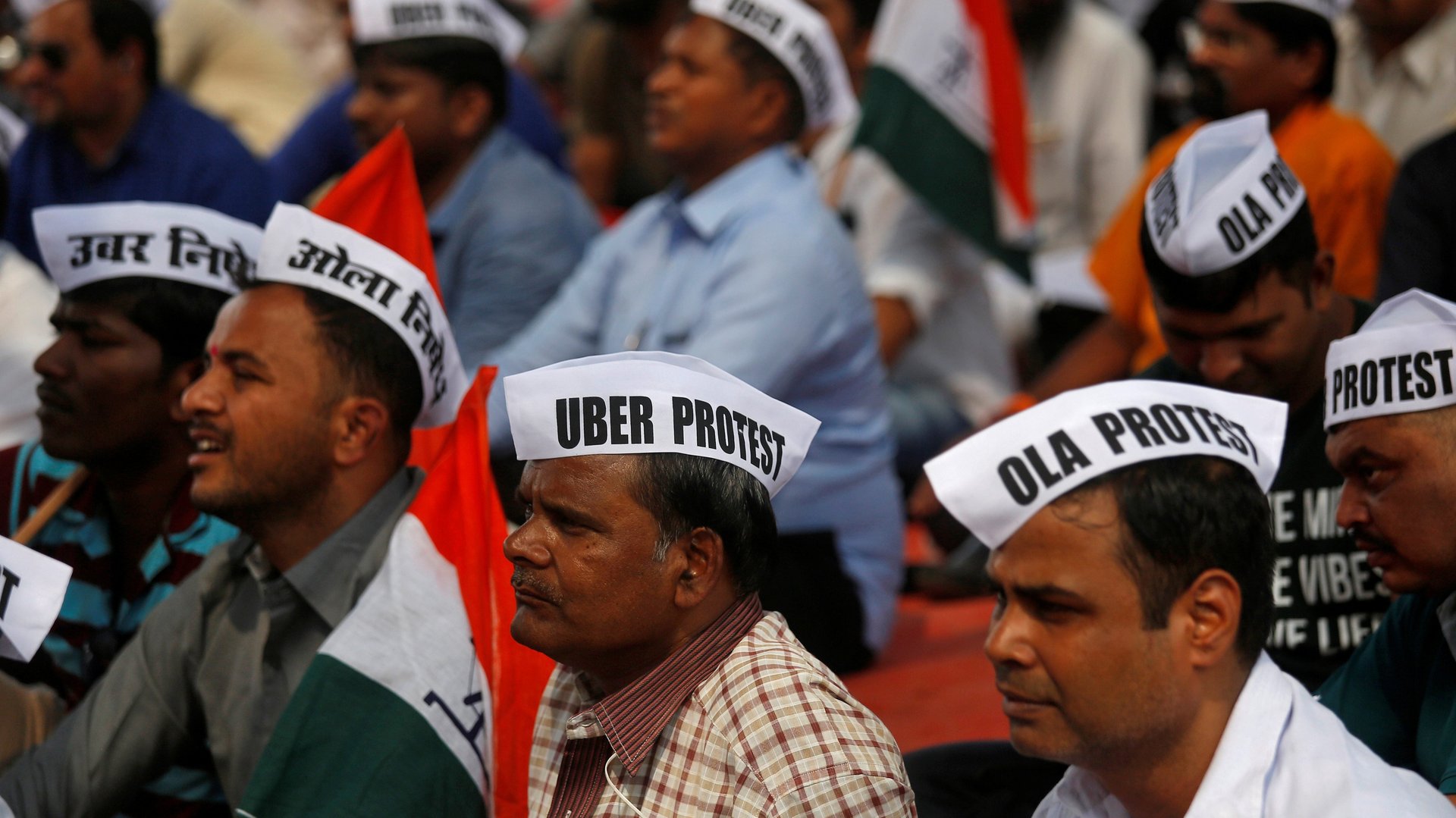What’s one of the fastest-growing jobs in India? (Hint: Ola has something to do with it)
More and more Indians are getting behind the wheel—professionally.


More and more Indians are getting behind the wheel—professionally.
People working in the “drivers and mobile-plant operators” occupational category in India nearly doubled from 2.2% in 2007-2008 to 4% in 2017-2018, according to data from the Periodic Labor Force Surveys (PLFS) released by the statistics ministry in May 2019 (pdf).
“Drivers and mobile-plant operators” mostly includes people working in this category as a primary job, and almost all drive—90% are “motor vehicle drivers,” data show. That makes driving the sixth-most common job (pdf) in India, according to the most detailed job data the government releases (pdf).
It’s also the second-fastest-growing occupational category in India, right after “labourers in mining, construction, manufacturing and transport.”
Fastest growing occupational categories in India:
Onboarding efforts
Some of this wave is courtesy of ride-hailing companies.
Half of India’s 1.3 billion population is below the age of 25, and ride-hailing companies are tapping into this demographic to recruit them as driver-partners.
Bengaluru-based Ola, which has an onboarding target of 500,000 drivers between 2016 and 2022, has been training young adults aged between 18 and 25 in skills such as driving, spoken English, customer centricity, smartphone usage, and the basics of finance, so they can become drivers. In 2017, it spun out Ola Skilling Pvt. Ltd. to cater specifically to driver training.
Besides the training push, the SoftBank-backed company has been offering incentives to get drivers on its platform by helping facilitate loans to buy cars, offering benefits such as medical insurance and scholarships for children, and giving cashbacks on fuel, among other things.
Meanwhile, American rival Uber teamed up with the Karnataka government to provide soft skills training to Scheduled Caste and Scheduled Tribe (SC/ST) communities who purchase cabs at subsidized rates under the Airavatha scheme.
Both Ola and Uber have tied up with the National Skill Development Corporation (NSDC) to train about half a million drivers between 2017 and 2020.
And with India’s unemployment rate ballooning—it hit a 45-year high of 6.1% in 2017-18—it’s not just the less-educated from the hinterlands that are eyeing these jobs. In 2016, some 40% of new college graduates equipped with bachelor’s degrees, faced with the dearth of white-collar jobs, were looking for blue-collar jobs such as office assistants, drivers, bartenders, maids, and mechanics were graduates instead, according to hiring platform QuikrJobs.
No job for women
Opportunities are ample in the mobility sector, but it is mostly men capitalizing on them.
While 4.7% of working men listed motor vehicle drivers as their job, only 0.02% of working women said they did this job. This makes motor vehicle driver by far the most heavily male-dominated job among any profession pursued by more than one in a thousand Indians.
In general, the jobs scenario for Indian women has been bleak. India’s female labour participation rate is among the world’s lowest. Women are less likely to work in India than any other country in the G20, except for Saudi Arabia. And among those who do choose to drive, the profession is often stigmatized and even considered unsafe.
“The male drivers wouldn’t come up and say anything. But I would get stares from them,” Uber’s first woman taxi driver in India, Veerath Bharathi, told Quartz in a 2015 interview. “It’s their (regressive) mindset, but that cannot really stop me from carrying on with my profession.” Bharathi, would only pick up female passengers during late-night or early-morning trips so she and the rider would both feel safer. Unfortunately, she was found hanging in her Bengaluru home in June 2016
Moreover, many women are not financially independent and lack the funds to buy a car.
However, small but concerted efforts are being made to change this gender dynamic: Delhi-based Azad Foundation started the “Women on Wheels” program in the capital back in 2008, training women from lower socio-economic backgrounds to become professional drivers. It has since expanded to Jaipur, Kolkata, Ahmadabad, Bangalore and Indore. Priyadarshini Cabs, the all-women taxi fleet launched in Mumbai in 2008 by social activist Susieben Shah, is set to get an app and start operations in Bengaluru and Delhi soon. Mumbai-based Viira Cabs and Bengaluru’s Women Cabs are also popular.
The government, too, is rallying behind putting more women in the driver’s seat, asking Uber and Ola to train female drivers.
These “by women, for women” options even extend to three- and two-wheeler aggregators like SMV Green Solutions in Varanasi, Chennai-based M-Auto, and Bikxie Pink in Gurugram.
But is working in this rapidly-growing sector really as rosy as it seems?
Coveted or cursed?
Though the number of drivers is on the rise, their earnings are going in the opposite direction.
When Ola and Uber first broke onto the scene in India in the early 2010s, drivers were earning hefty incomes because the companies were taking smaller cuts and doling out attractive incentives. Some people quit their 9-to-5 jobs and moved to driving. Others sold farmland in their villages and bought taxis.
In the last couple of years, though, the perks have faded. Over half a dozen drivers told Quartz India that their earnings have more than halved and they get fewer rides in off-peak hours because of the influx of cars on the ride-sharing platforms. Moreover, the drivers allege that ride-hailing firms Uber and Ola are taking higher commissions than they initially agreed on.
The pressure is mounting as it gets harder to pay back loans and banks repossess vehicles if timely repayments aren’t made. To add to the burden, petrol and diesel prices have been shooting up in the country.
Drivers have gone on strike to support their call for higher fares and for blacklisted drivers to be reinstated. Hardly any demands have been met thus far, drivers say.